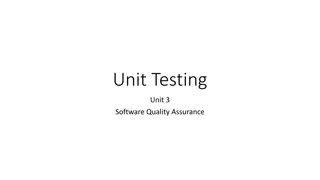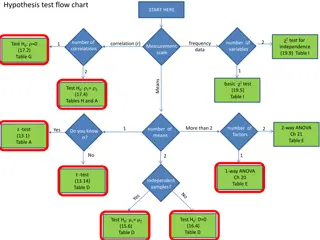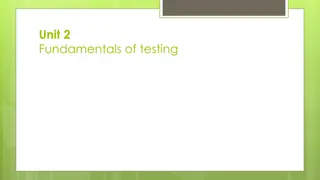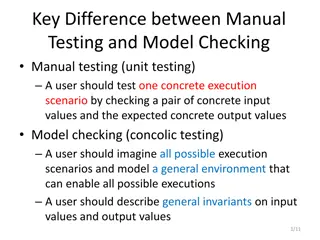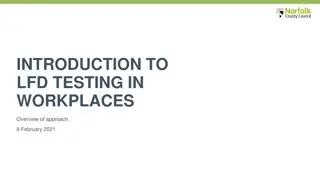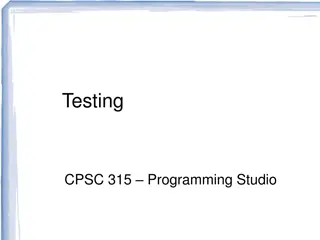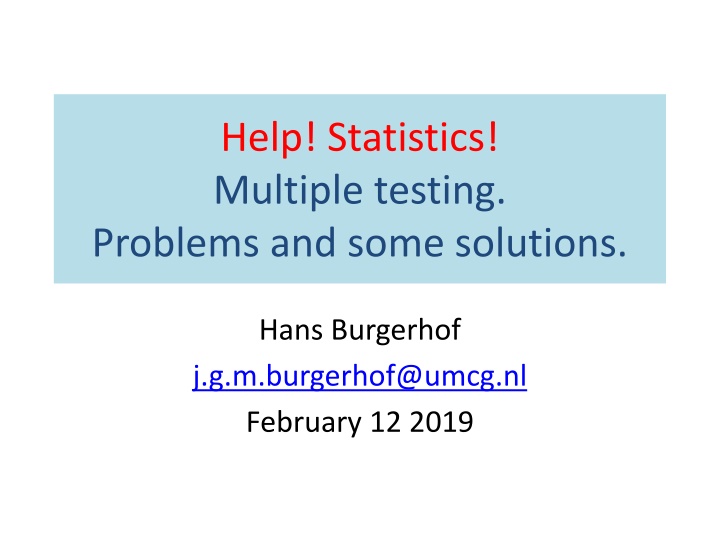
Multiple Testing Problems in Statistics
Learn about multiple testing issues in statistics, including controlling false discovery rates and familywise error rates. Discover how to manage Type I and Type II errors effectively. Gain insights into the probabilities involved in rejecting null hypotheses and making errors in statistical tests.
Download Presentation

Please find below an Image/Link to download the presentation.
The content on the website is provided AS IS for your information and personal use only. It may not be sold, licensed, or shared on other websites without obtaining consent from the author. If you encounter any issues during the download, it is possible that the publisher has removed the file from their server.
You are allowed to download the files provided on this website for personal or commercial use, subject to the condition that they are used lawfully. All files are the property of their respective owners.
The content on the website is provided AS IS for your information and personal use only. It may not be sold, licensed, or shared on other websites without obtaining consent from the author.
E N D
Presentation Transcript
Help! Statistics! Multiple testing. Problems and some solutions. Hans Burgerhof j.g.m.burgerhof@umcg.nl February 12 2019
Help! Statistics! Lunchtime Lectures What? frequently used statistical methods and questions in a manageable timeframe for all researchers at the UMCG No knowledge of advanced statistics is required. do not When? Lectures take place every 2ndTuesday of the month, 12.00-13.00 hrs. Who? Unit for Medical Statistics and Decision Making When? Where? What? Who? Feb 12 2019 Room 16 Multiple testing. Problems and some solutions Kaplan-Meier survival curves and the log rank test ? H. Burgerhof April 9 2019 Room 16 D. Postmus June 11 2019 ? ? Slides can be downloaded from http://www.rug.nl/research/epidemiology/download-area 2
Program Today 1. Multiple testing. What is the problem? 2. (Stochastically) independent tests versus dependent tests 3. Controlling the Familywise Error Rate (FWER) 4. Controlling the False Discovery Rate (FDR) 5. Some references (for finding more solutions)
Type I and Type II errors for a statistical test H0: effect new treatment = effect standard treatment H1: effect new treatment > effect standard treatment Decision H0 true H0 not true Reality H0 true OK Probability: 1 - Type I error Probability: H0 not true Type II error Probability: OK power Probability: 1 - The significance level is generally 0.05; We allow 5% probability to reject H0, while in fact it is true
The classical problem of multiple testing In statistical testing, we usually define the significance level at 0.05. This means we accept a probability of 0.05 to reject a null hypothesis, while in fact the null hypothesis is true This is called the Comparison-wise error rate (CWER) What can we say about the probability of rejecting at least one null hypothesis if we have more than one hypothesis to test? Chance capitalisation! Overall alpha Family-wise error rate (FWER)
FWER and CWER If we perform n independent tests, each with CWER = 0.05, then = 1 n . 0 ( 95 ) FWER the probability of making a type I error = 0.05 (in one test) Number of tests n overall alpha (FWER) The probabilty of not making a type I error (per test) = 1 0.05 = 0.95 3 10 100 0.143 0.401 0.994 The probability of making no type I errors in n independent tests = (0.95)? So, the probability of making at least one type 1 error equals 1 - (0.95)?
A simple, classical, example We would like to compare three independent groups with respect to a continuous, normally distributed, outcome variable. Performing all pairwise comparisons will take three tests (1 to 2, 1 to 3, 2 to 3). Three null hypotheses: ?1= ?2, ?1= ?3, ?2= ?3 will be tested. Are these hypotheses independent of each other? No: if ?1= ?2 is true and ?1= ?3 is true, automatically ?2= ?3 has to be true!
How to control the FWER at 0.05 in this situation? A. One-step procedure of Bonferroni. Perform all pairwise comparisons on CWER = 0.05 / c in which c equals the number of comparisons (in this case c = 3, so take CWER 0.0167) ???? = 1 1 0.01673 0.049 B. Two step procedure: Oneway ANOVA followed Post-hoc by pairwise comparisons. If the P-value of Oneway ANOVA 1, choose a suitable Post-hoc procedure. Perform pairwise tests on 2. What is a good choice for the s?
Choice of s for three groups In the case of three groups, you can take 1 = 2 = 0.05 and your overall is still 0.05! There are only three possible situations: ?1= ?2= ?3 protected because of the overall test ??= ?? ?? you can make only the type I error for ??= ?? ?1 ?2 ?3 you cannot make a type I error at all Using Bonferroni correction after a significant ANOVA is too conservative!
Multiple tests on cumulating data (dependent tests) Theory is used for interim analyses Armitage, McPherson en Rowe (1969) Tables with overall alpha after sequential tests for observations from Binomial, Normal en Exponential distributions As an illustration we will recalculate an example (n patients are treated with both A and B and have to tell which is better). H0: A= B= 0.5. We will test after each new patient.
A B A B A B A A etcetera A B A B X~B(n, 0.5) B B Overall alpha increases, but not as extreme as in the case of independent tests (100 independent tests: overall > 0.99) does no longer hold
Binomial distribution n = 1, .., 10 and = 0.5 P(k = 0) = P(k=n) n P(k = 0) = P(k = n) Two sided 1 2 3 4 5 6 7 8 0.5 0.25 0.125 0.0625 0.03125 0.015625 0.0078125 0.00390625 1 0.5 0.25 0.125 0.0625 0.03125 0.015625 0.0078125
H0: = 0.5; = 0.01 two sided (per test): total probability to reject if H0 is true :0.00781 (1) Number of successes for A Boundary is hit once X ~ B(7, 0.5) P(X = 0) = P(X = 7) = 0.57 0.0078 Two-sided: 0.0156 > X ~ B(8, 0.5) P(X=0) = P(X=8) 0.0039 Two sided: 0.0078 Reject H0 10 9 8 7 6 5 4 3 2 1 0 X ~ B(10, 0.5) P(X 1) = P(X 9) 0.0107 Do not reject H0 X~B(n, 0.5) 1 2 3 4 5 6 7 8 9 10 n Actual overall alpha is 0.0078
= 0.03 two sided (for each test): total probability to reject if H0 is true = 0.02930 (2) Number of successes for A X ~ B(10, 0.5) P(X 1) = P(X 9) 0.0107 Reject H0 10 9 8 7 6 5 4 3 2 1 0 X ~ B(7, 0.5) P(X = 0) = P(X= 7) 0.0078 P(X = 1) if n = 10 is P(X = 1) if n = 7 followed by three failures: 0.0547*(0.5) 0.0068 1 2 3 4 5 6 7 8 9 10 n Overall rounded 2*0.0078 + 2*0.0068 = 0.0293
Many independent tests We are interested in genes, possibly related to a certain disease. Example: We have 100 candidate genes and compare their expressions in a group of diseased respondents with the expressions in a group of non-diseased respondents. We test 100 (more or less) independent tests (H0: no effect). How to correct for multiple testing?
The 10 genes with smallest P-values No correction: = 0.05; 14 genes are significant Simple Bonferroni correction: * = 0.05/100 = 0.0005 Conclusion: only two genes are significant Can we do better?
The False Discovery Rate (FDR) Benjamini en Hochberg, 1995 FDR = the expected proportion of all rejected null hypotheses that has been rejected falsely not significant significant total True null hypotheses False null hypotheses U T V S m0 m1 Only m is known m R R m Only R can be observed! FDR = E(V/R)
The FDR not significant significant total True null hypotheses False null hypotheses U T V S m0 m1 m R R m Benjamini and Hochberg (1995): if all null hypotheses are true, so T = S = m1 = 0, than controlling the FDR equals controlling the FWER (so the overall alpha is smaller than a defined max)
About the FDR If, in reality, some of the null hypotheses are false, the FDR is smaller than the FWER. Controlling the FDR does not imply control over FWER, but will give you more power. The more null hypotheses are false, the larger the gain in power
Multiple testing according to Benjamini and Hochberg: FDR procedure m nulhypotheses: H1, H2, , Hm m P-values: P1, P2, , Pm Rank the P-values: P(1) P(2) P(m) Find k = the largest i holding P ( i ) q i m q = chosen level of control (e.g. 0.05 or 0.1) Reject all H(i)i= 1, 2, , k
Closer look at the FDR Sequential FDR is a bit conservative, specially if the number of false null hypotheses is relatively large Benjamini e.a. (2001): two step procedure in which the proportion true null hypotheses ( 0) is estimated in the first step and used to determine q is the second: r m 1 0 = m Storey (2002): direct method to estimate 0
How to estimate 0? 0 = m0/m not significant significant total True null hypotheses False null hypotheses U T V S m0 m1 m R R m What does the distribution of P-values look like, if the null hypothesis is true?
H0: = 100 0.04 0.03 sample 0.02 y What do you expect for the P-value? 0.01 0.0 60 80 100 120 140 x If H0 is true
H0: = 100 0.04 0.03 Equal areas 0.02 y 0.01 P(P-value < k) = k for 0 k 1 0.0 60 80 100 120 140 x If H0 is true the P-value has a uniform distribution on [0,1]
If the null hypothesis is false ..the P-value does not have a uniform distribution on [0 ; 1], you will find relatively more often small P-values Number of P-values P-values from m1 P-values from m0 0 1
Back to our 100 genes Find k = the largest i holding i ) P q i ( m (i) ?(?)=? ??(?) ?? ?(?)=? ??(?) ? For example, if q = 0.05: 3 genes will be significant (of which probably 5% are false discoveries)
Back to our 100 genes If we take q = 0.1? (we are willing to accept that about 10% of the selected genes in fact are false discoveries) (i) The FDR is a step-up prcedure!
literature Armitage P., McPherson K. and Rowe B. (1969) Journal of the Royal Statistical Society Series A. 132(2) 235 - 244 Austin S., Dialsingh I. and Altman N. (2014) Multiple hypothesis testing: a review. http://personal.psu.edu/nsa1/paperPdfs/Mult_Hyp_Review_final.pdf Benjamini Y. and Hochberg Y. (1995). Controlling the False Discovery Rate: a practical and powerful approach to multiple testing. Journal of the Royal Statistical Society Series B, 289-300 Benjamini, Y. and Yekutieli, D. (2001). The control of the false discovery rate in multiple testing under dependency. Annals of Statistics, 29, 1165- 1188. Storey J.D. (2002). A direct approach to false discovery rates. Journal of the Royal Statistical Society Series B, 479 498.


